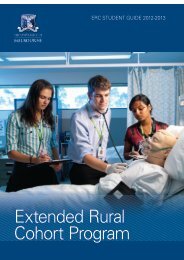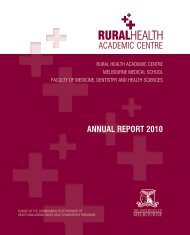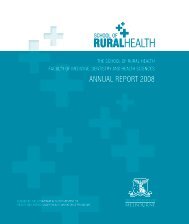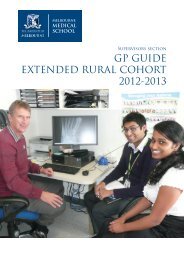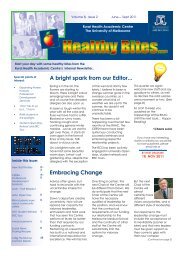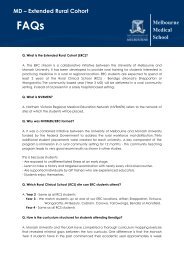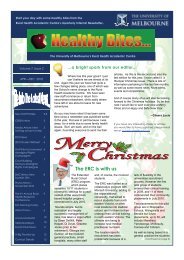Accommodation - School of Rural Health - University of Melbourne
Accommodation - School of Rural Health - University of Melbourne
Accommodation - School of Rural Health - University of Melbourne
You also want an ePaper? Increase the reach of your titles
YUMPU automatically turns print PDFs into web optimized ePapers that Google loves.
<strong>Health</strong> and Safety Representative Involvement<br />
An elected employee <strong>Health</strong> and Safety Representative for a<br />
designated work group may inspect the workplace immediately<br />
following an incident occurring, providing it is safe to do so.<br />
Supervisor Responsibilities<br />
Incident reports are normally received by the reporter’s supervisor.<br />
The supervisor is required to acknowledge the incident report. If the<br />
incident risk rating is medium, high or very high, then the supervisor<br />
must ensure that a formal incident investigation is completed. This<br />
would normally be undertaken by an incident investigation team.<br />
• Incident Investigation Teams - Requirements and<br />
Responsibilities<br />
The Incident Investigation Team may include the following<br />
participants:<br />
• Local supervisor or manager (Team Leader)<br />
• Persons involved in the incident and witnesses<br />
• <strong>Health</strong> and Safety Representative (if reasonably<br />
practicable)<br />
• EHS Adviser or local EHS Coordinator.<br />
EHS Incident Reporting<br />
& Investigation<br />
54<br />
The supervisor normally acts as the Team Leader. At least one<br />
team member should be trained in <strong>University</strong> <strong>of</strong> <strong>Melbourne</strong><br />
Incident Investigation methodology. The incident investigation<br />
team establishes the facts <strong>of</strong> circumstances leading up to the<br />
incident, during the incident and after the incident, by gathering and<br />
considering information including the effectiveness <strong>of</strong> the existing<br />
risk assessments and risk controls. More detailed advice on what<br />
to investigate is available in EHS Manual 14.1.4.4. New. Incident<br />
Investigation. The Incident Investigation team must recommend<br />
corrective actions to eliminate or reduce the risk <strong>of</strong> reoccurrence <strong>of</strong><br />
a similar incident so far as is reasonably practicable. The Incident<br />
Investigation Team Leader must provide a copy <strong>of</strong> the completed<br />
incident investigation report to the local EHS Committee and the<br />
EHS Adviser or Manager for the Faculty (Budget Division).<br />
The supervisor is responsible for ensuring that appropriate<br />
corrective actions are implemented or that the recommended<br />
corrective actions are escalated to a person responsible for<br />
implementation. The supervisor is required to ensure that when<br />
corrective actions are being implemented, the local personnel<br />
affected are consulted about the corrective actions. The supervisor<br />
is required to monitor progress <strong>of</strong> implementation <strong>of</strong> corrective<br />
actions and record when implementation <strong>of</strong> corrective actions is<br />
finalised.<br />
EHS Committee Responsibilities<br />
The Faculty/Division EHS Committee (or if applicable, the Local<br />
EHS Committee) is required to review incident investigation<br />
reports submitted by Incident Investigation Team Leaders. The<br />
EHS Committee is required to nominate a person (usually the EHS<br />
Coordinator) to review and report back to the committee on the<br />
effectiveness <strong>of</strong> the implemented control measures.





